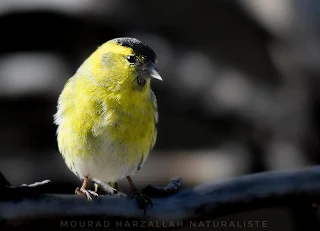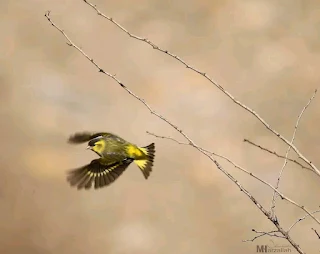Introduction
The Eurasian siskin , also known as the European siskin, embarks on a fascinating migration from Europe to North Africa. This small passerine bird, with its greyish-green plumage and distinctive yellow wing bar, thrives in forested areas, particularly among alder and conifer trees. Discover the secrets of its migratory path and the mysteries that surround its journey.”
👆🏻By Mourad Harzallah naturalist
The Alder Siskin (Spinus spinus), a small passerine bird, embarks on an awe-inspiring migration from the verdant forests of Europe to the warmer climates of North Africa. This article delves into the intricacies of the Alder Siskin's migration, its diet across different life stages, and the melodious songs that mark its presence.
Migration Path
The migration of the Alder Siskin is a testament to nature's marvels. Ringing recoveries have shown that these birds can travel at speeds varying between 20.2 and 260.0 km/day. Their journey is influenced by various factors, including food availability and weather conditions. As autumn arrives, the Alder Siskin sets off from Europe, crossing diverse landscapes to reach the hospitable habitats of North Africa.
Dietary Habits
The diet of the Alder Siskin is predominantly seed-based, with a particular fondness for the seeds of birch and alder trees. During the leaner winter months, they often venture into gardens, attracted by feeders offering peanuts and niger seeds. In summer, their palate diversifies to include insects and other herbaceous plants.
Life Stages
From the moment they hatch, Alder Siskins are nurtured in nests high up in the trees. After about two weeks, the fledglings leave the nest, embarking on their first flights. As they mature, these birds form cohesive flocks, their social structure evident in their communal roosting and foraging behaviors.
Bird Songs and Calls
The Alder Siskin's song is a distinctive aspect of his identity, often heard during his migratory sojourns. These vocalizations serve as a beacon, guiding flocks and enchanting listeners with their melodic quality.
Conclusion The Alder Siskin's migration is a remarkable phenomenon, showing the bird's adaptability and resilience. As they cross continents, these birds not only contribute to the biodiversity of their habitats but also enchant with their songs, embodying the spirit of avian migration.
Question for Readers: How does the Alder Siskin's migratory speed compare to other small passerine birds, and what factors might influence this speed during its journey to North Africa?
Answer :
The Alder Siskin's migratory speed is quite remarkable when compared to other small passerine birds. Studies have shown that migratory birds like the Alder Siskin have evolved to enhance flight efficiency, often having longer wings, higher aspect ratios, and lower wingbeat frequencies . These adaptations allow them to have a significantly lower maximum speed and power output, thus reducing flight energy costs and increasing energy efficiency for long-distance travel.
Several factors influence the migratory speed of the Alder Siskin during his journey to North Africa:
- Weather Conditions : Adverse weather can slow down migration, while favorable winds can speed it up.
- Stopover Site Quality : High-quality stopover sites with abundant food can reduce the time needed for refueling, allowing birds to resume their journey more quickly .
- Rate of Fuel Deposition : The rate at which birds can store fat as fuel for the journey affects how long they stay at stopovers and their overall migration speed .
- Competition : High competition at stopover sites can lead to longer stays, affecting the speed of migration
The overall speed of migration is greatly influenced by the time spent at stopover sites, with birds likely to spend more time foraging than flying during their journey. This strategic behavior ensures that they have enough energy reserves to reach their destination.
Conclusion The Alder Siskin's migration is a remarkable phenomenon, showing the bird's adaptability and resilience. As they cross continents, these birds not only contribute to the biodiversity of their habitats but also enchant with their songs, embodying the spirit of avian migration.




